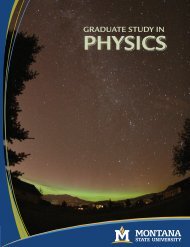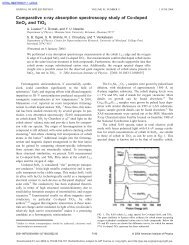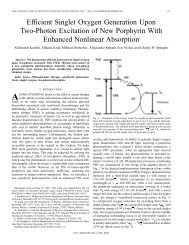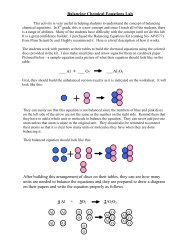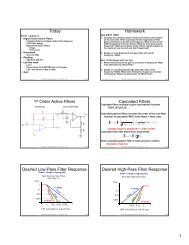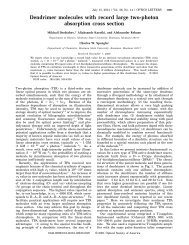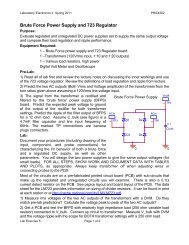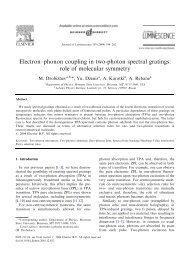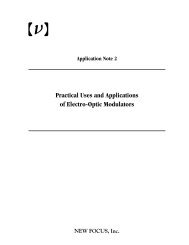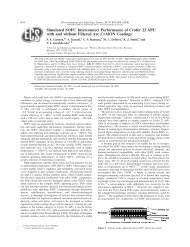Defects in inorganic photorefractive materials and their investigations
Defects in inorganic photorefractive materials and their investigations
Defects in inorganic photorefractive materials and their investigations
Create successful ePaper yourself
Turn your PDF publications into a flip-book with our unique Google optimized e-Paper software.
24 B. Briat et al.<br />
<strong>photorefractive</strong> properties of KNbO 3 [140]. Besides isolated Fe 3+<br />
Nb<br />
<strong>and</strong> Fe3+<br />
Nb<br />
-V O several low symmetry associations of Fe 3+<br />
Nb<br />
with unknown partners are<br />
reported. As grown, oxidized <strong>and</strong> reduced samples were <strong>in</strong>vestigated. Light<strong>in</strong>duced<br />
changes of EPR <strong>and</strong> optical absorption were observed <strong>in</strong> some cases,<br />
but only <strong>in</strong> one case with the same defect. Def<strong>in</strong>ite relations between Fe-defects<br />
<strong>and</strong> the <strong>photorefractive</strong> behavior of the crystals could not be established. Nor<br />
was it possible to decide experimentally whether Fe 2+ <strong>in</strong> KNbO 3 absorbs at<br />
2.55 eV [140]. With EPR/optical absorption it was established that the optical<br />
absorption of Fe 2+ has its peak at 2.1 eV <strong>in</strong> BT [115], at 1.9 eV <strong>in</strong> BCT [141]<br />
<strong>and</strong> at 1.5 eV <strong>in</strong> KTaO 3 [142] (Fig. 10).<br />
1400<br />
1000<br />
wavelength (nm)<br />
700 500<br />
400<br />
cubic Fe 3+<br />
tagged MCD /E(arb.units)<br />
3+<br />
Fe - VO<br />
rhombic Fe 3+<br />
3+<br />
Fe - OI<br />
4+<br />
Fe - OI<br />
cubic Fe 2+<br />
2+<br />
Fe - VO<br />
1 1.5 2 2.5 3 3.5<br />
photon energy E (eV)<br />
Fig. 10. MCD spectra of various<br />
Fe-conta<strong>in</strong><strong>in</strong>g defects <strong>in</strong> KaTO 3:Fe<br />
[143] assigned to the <strong>in</strong>dicated<br />
species by ODMR.<br />
In view of the obstacles to obta<strong>in</strong> detailed EPR <strong>in</strong>formation about defects<br />
<strong>in</strong> KNbO 3 , it was decided to <strong>in</strong>vestigate the similar KTaO 3 :Fe as a model<br />
system. Such crystals are cubic at all temperatures <strong>and</strong> thus facilitate the<br />
<strong>in</strong>vestigation by ODMR-MCD. At least eleven different Fe conta<strong>in</strong><strong>in</strong>g defects,<br />
most of them low symmetry associations, were found [143]. Fig. 10 shows<br />
a selection among them, characterized by <strong>their</strong> MCD spectra. Usually such<br />
b<strong>and</strong>s are overlapp<strong>in</strong>g <strong>in</strong> the same crystal; with the ODMR technique it is<br />
possible to select those b<strong>and</strong>s orig<strong>in</strong>at<strong>in</strong>g from a def<strong>in</strong>ite defect. S<strong>in</strong>ce the<br />
frequency ranges of the MCD structures are identical to those of the related<br />
absorption b<strong>and</strong>s, this plot shows at what energies to expect absorption b<strong>and</strong>s<br />
of the given defect configurations <strong>and</strong> charge states, also <strong>in</strong> the similar KNbO 3 .



